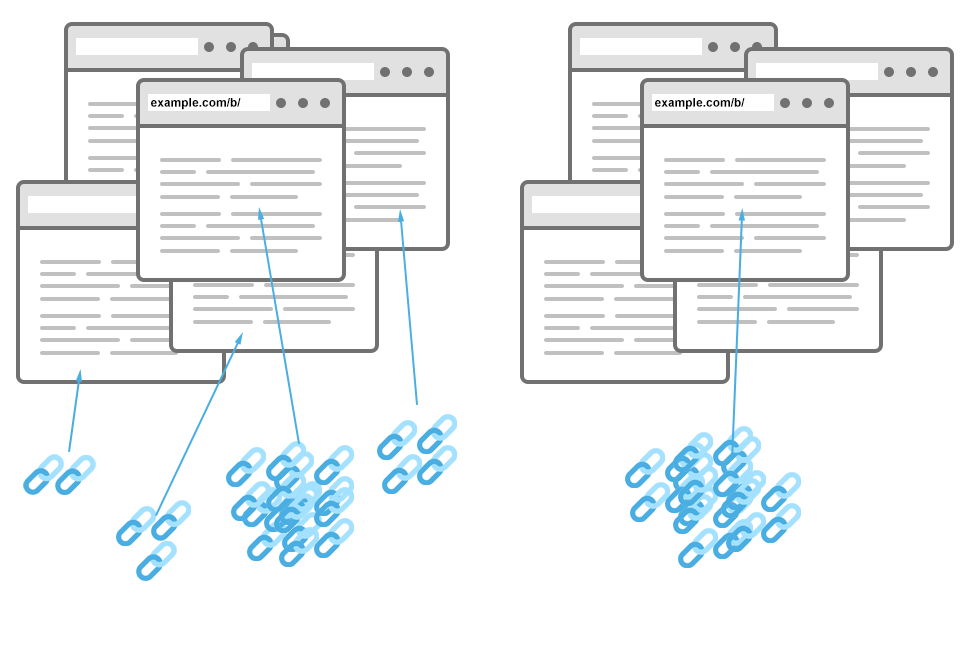Lesson 6.1 Additional Link Algorithms
Article by: Matt Polsky
Links, in general, are an authority metric. The more links you receive around a topic, the more authoritative your page or site should be on said topic.
However, just getting links won't always grow traffic, and there are many different ways Google could value links. Below are some historically validated algorithms and key concepts to understand on how links help from an SEO standpoint.
Note: This section and its examples focus solely on links and no other signal. It's possible to rank well without links (depending on the competition and niche) if you outweigh a competitor's links with other signals.
Anchor Text
Anchor text is the clickable text of a link. Algorithms use anchor text to determine if a page is authoritative for a given subject.
Suppose a page receives multiple links with anchor text revolving around Roth IRA eligibility. In this case, the page is likely authoritative on Roth IRA eligibility.

The page would also be more authoritative for Roth IRA eligibility than a similar page without links – or a similar page with links that lacked contextual anchor text. "Click here" is an example of anchor text lacking context. These links make it difficult to determine what a page should be authoritative for.
There are three primary types of anchor text:
- Exact match anchor text
- Partial match anchor text
- Junk anchor text
Exact Match
Exact match is anchor text that targets the head term. For example, if the head term is "Roth IRA," the anchor text pointing to a page would be "Roth IRA."
Exact match anchor text is typically the riskiest when done in mass. In the early days, exact match anchor text provided the most significant lift, so many SEOs attempted to build links with exact match anchor.
However, because of the effectiveness of exact match anchor, Google penalized sites that built large amounts of exact match links. Today they offer this guidance on their link schemes page:

Today, Google claims to devalue links with signs of manipulation vs. penalize, but manual penalties still happen.
Note: If I were building a new property, I'd be more aggressive on the anchor text and mellow out over time. I typically take a conservative approach on established properties and reserve exact match for the best links (where possible).
Partial Match
Partial match is anchor text that targets the primary term but includes more context. For example, if the head term is "Roth IRA," the anchor could be "how Roth IRAs work."
Partial match is typically the safest. It's more natural, provides additional context and longer links usually result in more clicks.
Junk Anchor
Junk anchor is anchor text without context. Junk anchor includes things like "click here," "go now," "see this," etc.

External Links > Internal Links
External links provide a stronger signal than internal links. You control every internal link, so Google doesn't weigh them as heavily as external links. If internal links were the standard, you could easily manipulate search results by creating thousands or millions of links to pages you wanted to rank.
That said, internal links play a vital role in optimizing a website. Internal links funnel external link equity throughout a site and allow you to assign hierarchy by showing what pages are the most important for given topics.
With internal links, there's less worry about anchor text manipulation. If you want to signal a page is about the Roth IRA, link away with that exact match anchor.
Page-Level and Domain-Level Metrics Differ
Page and domain-level metrics differ. A page with hundreds or thousands of links may not rank well for the key term if the domain itself lacks authority.
For example, consider two websites. Site A has 100 links spread across multiple pages, with one of the pages receiving 25 links alone. Site B has the same number of pages and 25 links to a single page but none anywhere else on the site. If the two pages targeted the same term and had the exact same links, Site A would outrank Site B.

A website appears more trustworthy and authoritative when many different pages receive links. A site with links to multiple deep pages signals the site offers a variety of resources worth referencing or sharing instead of just one.
You may hear the term "deep link" or "deep page." A deep link is a link that points to an internal page – meaning any page but the homepage.
Domain Authority and SEO Metrics
You'll undoubtedly run into Page Authority (PA) and Domain Authority (DA). You'll also likely see references to Trust Flow (TF), Citation Flow (CF), Domain Rating (DR), URL Rating (UR) and more. It's essential to understand none of these metrics come from Google. Google no longer provides an overall link metric to site owners. Typically on a 0 to 100 scale, these metrics come from private companies that try to reverse engineer Google's index and link graph to determine a site's authority.
While the numbers don't come from Google, the services tools like Ahrefs, Majestic, Semrush and Moz provide are invaluable. However, you should never take the broad number (e.g., DA 60) as accurate. These tools excel when conducting a link analysis and comparing the actual link profiles vs. trusting the number. For example, it's very common for scammers to artificially inflate DA and attempt to sell links from sites they artificially inflate.
Key Concept: as with all things in SEO, link metrics and algorithmic expectations vary by niche. In certain niches, sites with thousands of homepage links may rank higher for their key terms than sites with links spread throughout.
Google uses AI to determine what is normal for a niche, what could be manipulative and what stands out as extraordinary. When performing a link analysis, it's essential to run a competitive analysis to help determine niche expectations and guide strategy.
Reasonable Surfer Model
PageRank assumed that a "random surfer" randomly clicked links forever. However, link clicks aren't random. People put time and effort into deciding what to click – enter the Reasonable Surfer Model.
With the Reasonable Surfer, links with a higher probability of being clicked carry more value. Features associated with a link under the Reasonable Surfer Model that impact value might include:
- The position of the link on the page. Links in the body content pass more value than links in the header, sidebar or footer. Additionally, links above the fold in the body content pass more value than links towards the bottom of the page.
- Font size, weight, color or styling.
- If the link is in a list, the position of the link in the list.
- The number of words in the anchor text and the actual words in the anchor text.
- The context of the words before and after the link.
- How commercial the anchor text associated with a link might be.
- Type of link (e.g., text link, image link, JavaScript, etc.).
The thing to remember most about the reasonable surfer model is the more prominent or more likely a user is to click on a link, the more value that link passes.
Link Neighborhoods
The concept of link neighborhoods is that you tend to attract links from sites of similar quality and authority to your own.
Some of this varies by niche or what you choose to place on your site. Sites in nefarious niches (porn, gambling, pills, payday loans, etc.) often end up in these neighborhoods due to the lack of link prospects and extreme competitiveness.
Sites can find themselves in these neighborhoods by:
- Buying links
- Producing content that attracts these types of links
- Using tools and services that automatically place links

The Law of Diminishing Returns
The law of diminishing returns states that the first link you acquire from a specific domain will pass the most value and all others will be increasingly less valuable.
Suppose you became a writer for Forbes. In your first post, you link to a resource on your site. In theory, the equity from that link will be higher than any other future link from Forbes.
Think of it from an ease of acquisition standpoint. If it's easy to get a link from a specific site, Google often deems it less valuable. The key concept to remember is the most difficult links to acquire are often the most valuable.
However, it's a bit more complicated than the first link being the best you'll ever get. Time and frequency of links play a role in this equation and receiving fewer links over time results in less deterioration in equity.

Conversely, if you build hundreds or thousands of links consistently in a short amount of time, the equity flow is likely more parabolic in shape.

Basically, frequency over time shows how easy it is for you to get a link from a specific site. If that frequency appears above the norm, those links may be devalued or ignored.
Shared Ownership and Partnerships
Pre-existing relationships between sites can inhibit the ability for links to pass equity.
When sites appear to have the same ownership or partnership interests, the editorial integrity of the link comes into question and may result in a reduction of value.
It's relatively simple to judge and predict ownership and relationships between websites. These can include:
- Large numbers of reciprocated links
- Domain registration data
- On-site associations, such as privacy policies and legal disclaimers
- Publicized relationship information
Geographic Location
Geographic location also plays a role in a link's value. It's unnatural for an overseas website to cover a product only available in a specific country.
For example, a link from Canandian finance blog to the VA loan – a mortgage only for U.S. Veterans – is highly suspect.
Our next two lessons cover how to evaluate links and what types of links are "good" or "bad."
